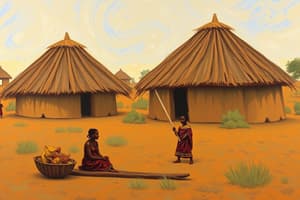Podcast
Questions and Answers
In which year was the Mali Empire founded?
In which year was the Mali Empire founded?
- 1250
- 1235 (correct)
- 1200
- 1300
What was the primary basis of the Mali Empire's economy?
What was the primary basis of the Mali Empire's economy?
- Mining
- Fishing
- Agriculture
- Trans-Saharan trade (correct)
What was the name of the capital city of the Mali Empire?
What was the name of the capital city of the Mali Empire?
- Niani (correct)
- Djenné
- Gao
- Timbuktu
Who was the founder of the Mali Empire?
Who was the founder of the Mali Empire?
What was the dominant religion in the Mali Empire?
What was the dominant religion in the Mali Empire?
What led to the decline of the Mali Empire?
What led to the decline of the Mali Empire?
Flashcards are hidden until you start studying
Study Notes
Geography and Foundation
- Located in West Africa, covering modern-day Mali, Senegal, The Gambia, and parts of Guinea, Burkina Faso, and Côte d'Ivoire
- Founded by Sundiata Keita in 1235, after defeating the Sosso Empire
- Capital city: Niani, Mali
Economy and Trade
- Based on trans-Saharan trade, particularly in gold, salt, and ivory
- Major trade routes: Timbuktu, Gao, and Djenné
- Control of the Niger River enabled trade with other regions
- Merchants from North Africa, Europe, and the Middle East traded with the Mali Empire
Social Structure and Politics
- Empire was divided into provinces, each with its own governor and administration
- The emperor (Mansa) held absolute power, advised by a council of elders
- Social hierarchy: nobles, freemen, and slaves
- Islam was the dominant religion, with a mix of traditional African practices
Notable Rulers
- Sundiata Keita (1235-1255): Founder of the empire, credited with its expansion and prosperity
- Mansa Musa I (1307-1332): Famed for his pilgrimage to Mecca, which showcased the empire's wealth
- Mansa Suleiman (1341-1360): Strengthened the empire's military and administrative systems
Decline and Legacy
- Weakened by internal conflicts, regionalism, and the rise of neighboring empires (e.g., Songhai)
- Fragmented into smaller kingdoms, including the Bamana Empire, in the 16th century
- The Mali Empire's legacy includes its cultural and economic achievements, as well as its role in the spread of Islam in West Africa
Geography and Foundation
- Located in West Africa, covering modern-day Mali, Senegal, The Gambia, and parts of Guinea, Burkina Faso, and Côte d'Ivoire
- Founded in 1235 by Sundiata Keita after defeating the Sosso Empire
- Capital city: Niani, Mali
Economy and Trade
- Based on trans-Saharan trade, particularly in gold, salt, and ivory
- Major trade routes: Timbuktu, Gao, and Djenné
- Control of the Niger River enabled trade with other regions
- Merchants from North Africa, Europe, and the Middle East traded with the Mali Empire
Social Structure and Politics
- Empire was divided into provinces, each with its own governor and administration
- The emperor (Mansa) held absolute power, advised by a council of elders
- Social hierarchy: nobles, freemen, and slaves
- Islam was the dominant religion, with a mix of traditional African practices
Notable Rulers
- Sundiata Keita (1235-1255): Founder of the empire, credited with its expansion and prosperity
- Mansa Musa I (1307-1332): Famed for his pilgrimage to Mecca, showcasing the empire's wealth
- Mansa Suleiman (1341-1360): Strengthened the empire's military and administrative systems
Decline and Legacy
- Weakened by internal conflicts, regionalism, and the rise of neighboring empires (e.g., Songhai)
- Fragmented into smaller kingdoms, including the Bamana Empire, in the 16th century
- Legacy includes cultural and economic achievements, as well as its role in the spread of Islam in West Africa
Studying That Suits You
Use AI to generate personalized quizzes and flashcards to suit your learning preferences.




